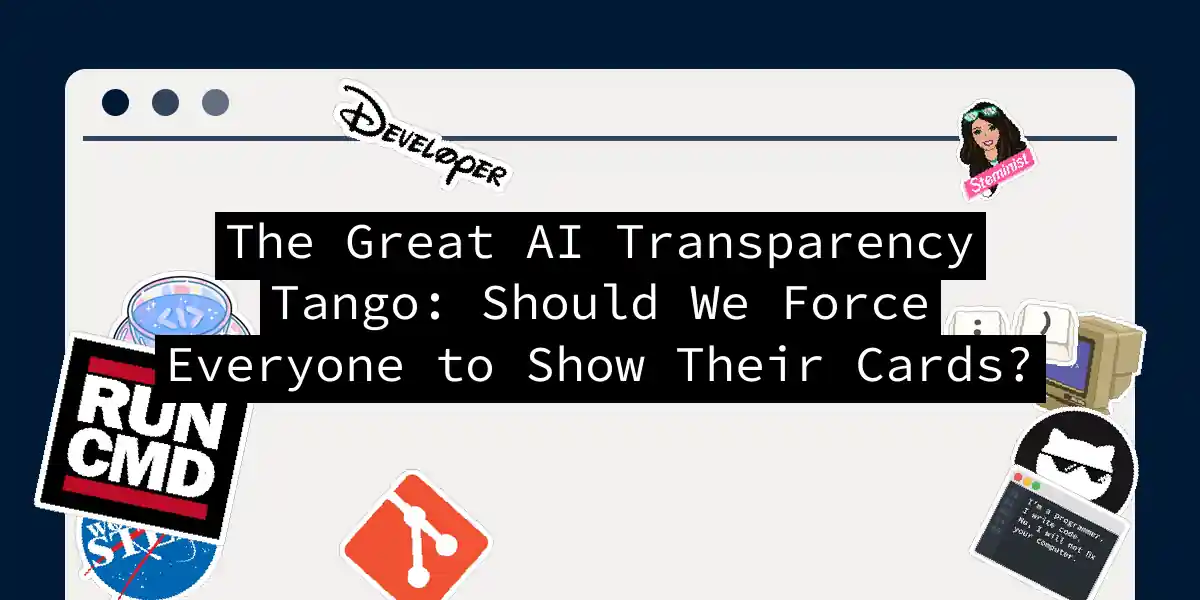Let’s start with a thought experiment: imagine if every chef was required to publish their secret recipes by law. The culinary world would either become a utopia of shared knowledge or descend into anarchy of copycat carbonara. Now replace “chefs” with “AI developers” and “recipes” with “model weights” - welcome to the main course of today’s debate.
The Current AI Kitchen: Secret Sauces and Mystery Meat
Modern AI development often feels like watching a magic show where:
- The rabbit comes out of the hat 🎩
- The audience applauds 👏
- Nobody questions where the rabbit lived before the trick 🐇
We’ve got AI systems making loan decisions, diagnosing cancers, and writing better love letters than I ever could. But when you ask developers, “What’s in this thing?”, you often get the digital equivalent of “11 herbs and spices” - except we’re not frying chicken, we’re shaping societal outcomes.
Code Sample: Peeking Under the Hood
Here’s how you might inspect an AI model today (if you’re lucky):
from transformers import AutoModelForCausalLM
try:
model = AutoModelForCausalLM.from_pretrained("super-secret-ai")
print(model.config)
except Exception as e:
print(f"Error: {str(e)}")
print("(Probably because the weights are locked in a virtual Fort Knox)")
The Case for Mandatory Open-Sourcing: Democracy’s Debugging Tool
Proponents argue that sunlight is the best disinfectant. Let’s break down their arguments with some code-like logic:
enum EthicalArgument {
BiasDetection,
SecurityAudits,
ScientificReproducibility,
PreventingRegulatoryCapture,
}
impl EthicalArgument {
fn enforce(&self) -> Result<Transparency, CorporatePushback> {
match self {
Self::BiasDetection => audit_training_data(),
Self::SecurityAudits => check_model_weights(),
Self::ScientificReproducibility => replicate_results(),
Self::PreventingRegulatoryCapture => break_monopolies(),
}
}
}
Real-world example: When researchers found gender bias in Meta’s LLaMA-2, it took 3 weeks and a small army of PhDs to diagnose the issue. With full transparency, this could’ve been:
grep 'sexism' training_data/*.txt | wc -l
The Counterarguments: When Open Source Becomes Open Season
Detractors warn that mandatory disclosure could create an AI wild west. Consider this security nightmare:
Recent examples include:
- The “Robin Hood” LLM that automatically granted loan approvals to anyone named “Robin”
- Facial recognition systems that work best for paleontologists (they’re great with bones) There’s also the innovation paradox: forcing open-sourcing could:
- 🚫 Stifle commercial investment
- 🧑💻 Create a generation of “AI parasites”
- 📉 Reduce quality through “too many cooks” syndrome
The Middle Path: Regulatory Circuit Breakers
Instead of blanket mandates, what if we created “ethical circuit breakers”? Here’s my proposal for graduated disclosure:
class AIDisclosureFramework:
def __init__(self, model_size, use_case, societal_impact):
self.transparency_level = self.calculate_transparency(
model_size, use_case, societal_impact)
def calculate_transparency(self, *args):
if args == 'high':
return {
'training_data': True,
'model_weights': True,
'api_access': 'full'
}
elif args == 'cat-gif-generator':
return {'disclosure': 'lol no'}
else:
return {'documentation': 'partial'}
Practical implementation steps:
- Ethical Impact Assessment (using tools like IBM’s AIF360)
python -m aif360.checklist --model=my_model.pth --output=ethics_report.pdf - Selective Disclosure Registries
CREATE TABLE ai_disclosure ( model_id UUID PRIMARY KEY, training_data_hash VARCHAR(64), bias_audit BOOLEAN, legal_watermark TEXT ); - **Compliance CI/CD Pipeline
FROM ethical-ai-base:v2.3 RUN model-audit --full-transparency --fail-on-bias=0.2 COPY legal/disclosure_report.md /usr/share/ai-compliance/
The Developer’s Dilemma: Coding Ethics into Existence
For those wanting to lead the charge, here’s a practical toolkit:
# Ethical AI Starter Pack
from ethics_toolkit import (
BiasDetector,
TransparencyLogger,
RegulatoryCompiler
)
class MyModel(nn.Module):
def __init__(self):
self.ethical_guardrails = {
'max_bias_threshold': 0.05,
'required_disclosures': ['training_sources', 'validation_metrics'],
'compliance_framework': 'EU_AI_ACT_2024'
}
def forward(self, x):
with TransparencyLogger() as auditor:
output = super().forward(x)
auditor.log_decision_path(self, x, output)
return output
The Punchline: Where Do We Draw the Line?
The great open-source debate boils down to:
- Transparency maximalists: “If you’ve got nothing to hide, you’ve got nothing to fear!”
- Practical realists: “Ever tried herding 10,000 GPU-hours?”
- Ethical nihilists: “It’s all gonna blow up anyway 🎉” As I write this, three companies are lobbying to have “AI” redefined as “Advanced Inspiration” to avoid regulations. Meanwhile, an open-source collective in Berlin is trying to train an ethics model using nothing but public domain philosophy texts and Taylor Swift lyrics. Perhaps the solution lies not in legal mandates, but in creating:
- Ethical impact bonds (reward good behavior)
- Bug bounties for bias ($10k for finding racist chatbots!)
- AI ingredient labels (35% academic papers, 15% Wikipedia, 50% random tweets) So, should all models be open-source by law? My take: Let’s require what’s needed for meaningful accountability, but leave room for secret sauce - as long as we can test for food poisoning first. What’s your recipe for ethical AI? Share your thoughts below - unless you’re a corporate lawyer, in which case please remain in your soundproof cage match with my inner idealist.
